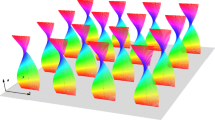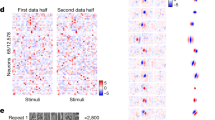Abstract
In this paper, we extend a framework for constructing low-dimensional dynamical systems models of mammalian primary visual cortex to a cortical network model that incorporates the full nonlinear effects of complex cells. The procedure consists of capturing the essential dynamics in a low-dimensional subspace using empirical methods, then recasting the equations in the reduced vector space. Previously, we considered visual cortical network models consisting of only simple cells with nearly linear responses to external stimuli. Here we show that fully nonlinear effects can be incorporated by examining the dimensional reduction of an idealized ring model of V1 with both simple and complex cells. We found it expedient to divide the subspace into four separate neuronal populations: excitatory simple, excitatory complex, inhibitory simple and inhibitory complex. In order to reproduce the fluctuation-driven dynamics in this reduced space, we incorporated (1) white noises with different intensities into individual neuronal populations, and (2) firing rate estimates to capture the probability of firing due to subthreshold fluctuations. With a more accurate, fitted connectivity, our modified dimensional reduced models can reproduce the firing rates, circular variances and modulation ratios observed in the original ring model.








Similar content being viewed by others
Notes
Orientation selectivity for drifting grating stimuli is measured by CV. Let m k denote the time-averaged firing rate with respect to stimulus angle θ k . The angles θ k spanned the range from 0 to 180° with equally spaced intervals. CV is defined as \( \mathrm{CV}=1-\left|{\displaystyle \sum_k{m}_k}{e}^{i2{\theta}_k}\right|/{\displaystyle \sum_k{m}_k} \). CV lies in the range of [0, 1]. Neurons with bad selectivity to orientation have CVs near 1, whereas neurons with good selectivity have CVs near 0.
Modulation ratio F1/F0 is defined as \( \mathrm{F}1/\mathrm{F}0=\left|{\displaystyle \sum_{n=1}^N\overline{R_n}{e}^{- i2\pi \left( n-1\right)/ N}}\right|/{\displaystyle \sum_{n=1}^N\overline{R_n}} \), where \( \overline{R_n} \) is the cycle-averaged response to a sinusoidal drifting grating. Usually, F1/F0 is in the range from 0 to 1.
References
Antoulas, A. C. (2005). Approximation of large-scale dynamical systems, Siam.
Cai, D., Tao, L., et al. (2006). Kinetic theory for neuronal network dynamics. Communications in Mathematical Sciences, 4(1), 97–127.
Chance, F. S., Nelson, S. B., et al. (1999). Complex cells as cortically amplified simple cells. Nature Neuroscience, 2(3), 277–282.
De Valois, R. L., Albrecht, D. G., et al. (1982). Spatial frequency selectivity of cells in macaque visual cortex. Vision Research, 22(5), 545–559.
DeAngelis, G. C., Ghose, G. M., et al. (1999). Functional micro-organization of primary visual cortex: receptive field analysis of nearby neurons. The Journal of Neuroscience, 19(10), 4046–4064.
Everson, R., Prashanth, A., et al. (1998). Representation of spatial frequency and orientation in the visual cortex. Proceedings of the National Academy of Sciences, 95(14), 8334–8338.
FitzHugh, R. (1961). Impulses and physiological states in theoretical models of nerve membrane. Biophysical Journal, 1(6), 445–466.
Fourcaud-Trocmé, N., Hansel, D., et al. (2003). How spike generation mechanisms determine the neuronal response to fluctuating inputs. The Journal of Neuroscience, 23(37), 11628–11640.
Friston, K. J., Frith, C. D., et al. (1995). Characterizing dynamic brain responses with fMRI: a multivariate approach. NeuroImage, 2(2PA), 166–172.
Gerstner, W. (2000). Population dynamics of spiking neurons: fast transients, asynchronous states, and locking. Neural Computation, 12(1), 43–89.
Hansel, D., Mato, G., et al. (1998). On numerical simulations of integrate-and-fire neural networks. Neural Computation, 10(2), 467–483.
Hubel, D. H., & Wiesel, T. N. (1962). Receptive fields, binocular interaction and functional architecture in the cat’s visual cortex. The Journal of Physiology, 160(1), 106.
Knight, B. W. (1972). Dynamics of encoding in a population of neurons. The Journal of General Physiology, 59(6), 734–766.
Knight, B. W., Omurtag, A., et al. (2000). The approach of a neuron population firing rate to a new equilibrium: an exact theoretical result. Neural Computation, 12(5), 1045–1055.
Laing, C. R., Frewen, T. A., et al. (2007). Coarse-grained dynamics of an activity bump in a neural field model. Nonlinearity, 20, 2127–2146.
Laing, C. R., Frewen, T., et al. (2010). Reduced models for binocular rivalry. Journal of Computational Neuroscience, 28(3), 459–476.
Lorenz, E. N. (1956). “Empirical orthogonal functions and statistical weather prediction.”
McKeown, M. J., Jung, T.-P., et al. (1998). Spatially independent activity patterns in functional MRI data during the Stroop color-naming task. Proceedings of the National Academy of Sciences, 95(3), 803–810.
McLaughlin, D., Shapley, R., et al. (2000). A neuronal network model of macaque primary visual cortex (V1): orientation selectivity and dynamics in the input layer 4Calpha. Proceedings of the National Academy of Sciences of the United States of America, 97(14), 8087–8092.
Nagumo, J., Arimoto, S., et al. (1962). An active pulse transmission line simulating nerve axon. Proceedings of the IRE, 50(10), 2061–2070.
Nykamp, D. Q., & Tranchina, D. (2000). A population density approach that facilitates large-scale modeling of neural networks: Analysis and an application to orientation tuning. Journal of Computational Neuroscience, 8(1), 19–50.
Ringach, D. L., Shapley, R. M., et al. (2002). Orientation selectivity in macaque V1: diversity and laminar dependence. The Journal of Neuroscience, 22(13), 5639–5651.
Rodriguez, J., & Sirovich, L. (1990). Low-dimensional dynamics for the complex Ginzburg-Landau equation. Physica D: Nonlinear Phenomena, 43(1), 77–86.
Shelley, M., & McLaughlin, D. (2002). Coarse-grained reduction and analysis of a network model of cortical response: I. Drifting grating stimuli. Journal of Computational Neuroscience, 12(2), 97–122.
Sirovich, L. (1987). Turbulence and the dynamics of coherent structures. Brown University: Division of Applied Mathematics.
Skottun, B. C., De Valois, R. L., et al. (1991). Classifying simple and complex cells on the basis of response modulation. Vision Research, 31(7), 1078–1086.
Sornborger, A., Sailstad, C., et al. (2003a). Spatiotemporal analysis of optical imaging data. NeuroImage, 18(3), 610–621.
Sornborger, A., Sirovich, L., et al. (2003b). Extraction of periodic multivariate signals: mapping of voltage-dependent dye fluorescence in the mouse heart. Medical Imaging, IEEE Transactions on, 22(12), 1537–1549.
Sornborger, A., Broder, J., et al. (2008). Estimating weak ratiometric signals in imaging data. II. Meta-analysis with multiple, dual-channel datasets. JOSA A, 25(9), 2185–2194.
Subasi, A., & Ismail Gursoy, M. (2010). EEG signal classification using PCA, ICA, LDA and support vector machines. Expert Systems with Applications, 37(12), 8659–8666.
Tao, L., & Sornborger, A. T. (2010). Dimensionally-reduced visual cortical network model predicts network response and connects system- and cellular-level descriptions. Journal of Computational Neuroscience, 28(1), 91–106.
Tao, L., Shelley, M., et al. (2004). An egalitarian network model for the emergence of simple and complex cells in visual cortex. Proceedings of the National Academy of Sciences of the United States of America, 101(1), 366–371.
Tao, L., J. D. Lauderdale, et al. (2011). “Mapping functional connectivity between neuronal ensembles with larval zebrafish transgenic for a ratiometric calcium indicator.” Frontiers in neural circuits, 5(2), 1–11.
Tao, L., Praissman, J., et al. (2012). Improved dimensionally-reduced visual cortical network using stochastic noise modeling. Journal of Computational Neuroscience, 32(2), 367–376.
Xing, D., Ringach, D. L., et al. (2011). Untuned suppression makes a major contribution to the enhancement of orientation selectivity in macaque v1. The Journal of Neuroscience, 31(44), 15972–15982.
Xu, J., Sornborger, A. T., et al. (2008). Drosophila TRPA channel modulates sugar-stimulated neural excitation, avoidance and social response. Nature Neuroscience, 11(6), 676–682.
Acknowledgments
This work was supported by the Ministry of Science and Technology of China (Basic Research Program 973 Program 2011CB809105) and the Natural Science Foundation of China (grant number 91232715). We thank Andrew Sornborger for reading and commenting on a earlier draft of this paper.
Conflict of interest statement
The authors declare that they have no conflict of interest.
Author information
Authors and Affiliations
Corresponding author
Additional information
Action Editor: David Golomb
Rights and permissions
About this article
Cite this article
Wang, C., Tao, L. Dimensional reduction of a V1 ring model with simple and complex cells. J Comput Neurosci 37, 481–492 (2014). https://doi.org/10.1007/s10827-014-0516-6
Received:
Revised:
Accepted:
Published:
Issue Date:
DOI: https://doi.org/10.1007/s10827-014-0516-6




